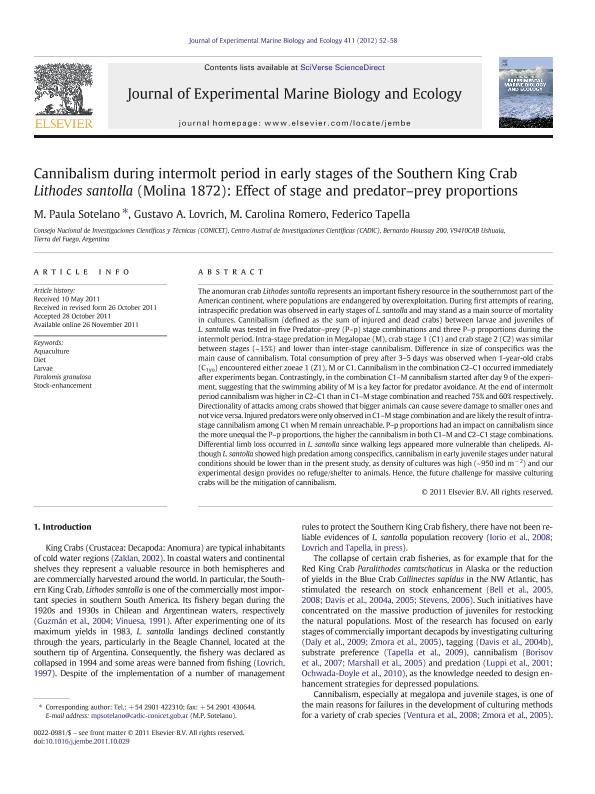Artículo
Cannibalism during intermoult period in early stages of the Southern King Crab Lithodes santolla (Molina 1872): Effect of stage and predator-prey proportions
Fecha de publicación:
01/2012
Editorial:
Elsevier Science
Revista:
Journal of Experimental Marine Biology and Ecology
ISSN:
0022-0981
Idioma:
Inglés
Tipo de recurso:
Artículo publicado
Clasificación temática:
Resumen
The anomuran crab Lithodes santolla represents an important fishery resource in the southernmost part of the American continent, where populations are endangered by overexploitation. During first attempts of rearing, intraspecific predation was observed in early stages of L. santolla and may stand as a main source of mortality in cultures. Cannibalism (defined as the sum of injured and dead crabs) between larvae and juveniles of L. santolla was tested in five Predator-prey (P-p) stage combinations and three P-p proportions during the intermolt period. Intra-stage predation in Megalopae (M), crab stage 1 (C1) and crab stage 2 (C2) was similar between stages (~15%) and lower than inter-stage cannibalism. Difference in size of conspecifics was the main cause of cannibalism. Total consumption of prey after 3-5days was observed when 1-year-old crabs (C 1yo) encountered either zoeae 1 (Z1), M or C1. Cannibalism in the combination C2-C1 occurred immediately after experiments began. Contrastingly, in the combination C1-M cannibalism started after day 9 of the experiment, suggesting that the swimming ability of M is a key factor for predator avoidance. At the end of intermolt period cannibalism was higher in C2-C1 than in C1-M stage combination and reached 75% and 60% respectively. Directionality of attacks among crabs showed that bigger animals can cause severe damage to smaller ones and not vice versa. Injured predators were only observed in C1-M stage combination and are likely the result of intra-stage cannibalism among C1 when M remain unreachable. P-p proportions had an impact on cannibalism since the more unequal the P-p proportions, the higher the cannibalism in both C1-M and C2-C1 stage combinations. Differential limb loss occurred in L. santolla since walking legs appeared more vulnerable than chelipeds. Although L. santolla showed high predation among conspecifics, cannibalism in early juvenile stages under natural conditions should be lower than in the present study, as density of cultures was high (~950indm -2) and our experimental design provides no refuge/shelter to animals. Hence, the future challenge for massive culturing crabs will be the mitigation of cannibalism.
Palabras clave:
AQUACULTURE
,
DIET
,
LARVAE
,
PARALOMIS GRANULOSA
,
STOCK-ENHANCEMENT
Archivos asociados
Licencia
Identificadores
Colecciones
Articulos(CADIC)
Articulos de CENTRO AUSTRAL DE INVESTIGACIONES CIENTIFICAS
Articulos de CENTRO AUSTRAL DE INVESTIGACIONES CIENTIFICAS
Citación
Sotelano, María Paula; Lovrich, Gustavo Alejandro; Romero, Maria Carolina; Tapella, Federico; Cannibalism during intermoult period in early stages of the Southern King Crab Lithodes santolla (Molina 1872): Effect of stage and predator-prey proportions; Elsevier Science; Journal of Experimental Marine Biology and Ecology; 411; 1-2012; 52-58
Compartir
Altmétricas




